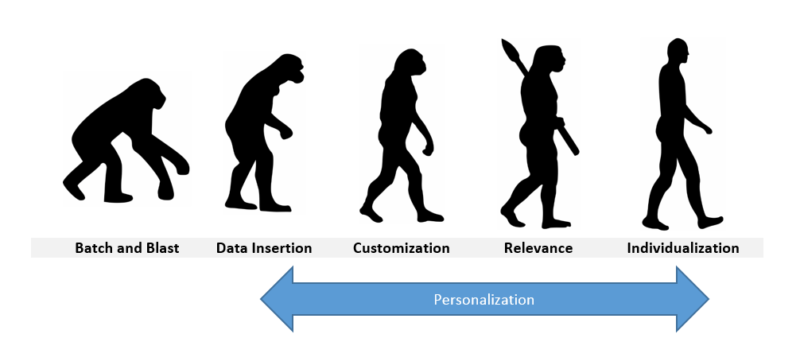The road map to personalization
Personalization can be time-consuming and complex, but it's critical to a successful email program. Columnist Jose Cebrian helps you streamline the process by breaking it down into a series of steps.

We hear it all the time: Marketing must be personalized to drive engagement and keep people engaged. True. But what does that really mean, and how do you get there?
At its most basic level, personalization is a message whose content is tailored to the stated or implied needs or interests of the recipient. Personalization is made up of two components: data and content.

The term “personalization” is used to describe everything from adding someone’s name into an email to using predictive analytics to send a re-engagement email when a subscriber is likely to become inactive.
Since each of these things is, technically, personalization, we break down personalization as a series of steps in the evolution of your email program:

Personalization: The data
Hopefully, your days of batch and blast are distant memories, and once you’re ready to move beyond simple data insertion, there are basically two sources of data you can tap into to evolve the personalization of your email program. They can be leveraged in tandem or alone:
- Use your own data that you collect and “model” for campaign and content selection.
- Leverage an outside service that collects information at the time of open and can serve content relevant to that information.
Customization
Preference Centers: A much-heralded feature where a person goes to a site and selects what they want to hear about.
My personal view is that preference centers are good from a permissions perspective if you have several communications channels (email, SMS, phone, direct mail) running and you want to provide a single place for customers to opt in or out, or if you have a product offering that is specific and long-lasting.
For example, if you are a large company, and a customer would likely want information specific to a product line only, then it may be worthwhile to ask for a product preference. But for many, especially retailers with thousands of SKUs, the idea that someone’s interests hold over time is difficult to believe.
The core problem with preference centers is that very few customers use them, so their use in personalization is ultimately limited.
Relevance
Contextual content: Use environmental data to tailor the message at the time of open.
By environmental data, I mean what we can know about them based on their location at the time of open, weather, device type and so forth. These data are usually provided by an outside service that can augment it, combined with data you have internally.
Using these data, you can better segment which content to show each individual. For example, a national retailer may use home location or open location to determine whether or not to show a parka in January. The point is that this is a shortcut to collecting data, but instead using data that are immediately available.
Link categorization: Categorize all of the links in your emails, and depending on what people click on, infer some level of interest or preference.
This is where the rubber meets the road, because you can triangulate what people are interested in if you do it over time. The challenge to this is setting up tracking properly — it takes more time, and the analysis of who is clicking on what can be complicated if you are doing more than simply seeing whether or not someone clicked on a link with a specific categorization.
If you start to do any trending or priority of categorization, this generally requires a tool set beyond an ESP (email service provider) to determine priority of interests. But once you have some level of categorization, you have information that allows you to do two things:
- Select people for an email that was already going to be focused on that type of content.
- Use the information to tailor content in an email.
Adding site activity
An advancement on link categorization is leveraging site tagging to understand what a person is looking at or has looked at to inform selection criteria for a campaign or a piece of content.
Today, a mini-industry has popped up inside of the email industry to send “triggered” emails based on particular page views because many of the larger traditional email platforms have failed to capitalize on this need. But that “triggered message” industry is ultimately geared toward sending an email in the moment vs. understanding site actions over time and using that information for content selection.
Doing this the right way and understanding actions and interests over time requires connecting site analytics data to an individual, either through a login or clicking on an email address. Once the data are connected, you can use that connection to go back in time to understand an individual’s actions on your site to inform your marketing.
Individualization
360-degree view/marketing database: Leverage all of your data to inform interest, position in lifecycle, past purchase and so on.
The most advanced basis of information from which to personalize emails is the marketing database, which takes in all of the above information and adds customer service transactions, past offline behavior, social data and more.
There are several data sources that can be integrated, but that’s not the point. The point is that the data are then used to power several propensity models on churn, email cadence, product propensity and more. These models then determine which content to serve and when to serve it.
Personalization: The (exponential) content layer
Generally, when beginning a personalization program, it’s the data component that many marketers get hung up on or believe is too difficult to set up. In reality, while the data side of things is complex, where I usually see brands struggle is in developing content.
You might be thinking, “I already have plenty of content,” or “I can create content pretty easily,” and while that may be the case, personalization adds a need for (literally) exponentially more versions.
For example, let’s say you manage the email marketing program for an insurance company. After examining your data, you determine that there are three main segments your customers fall into:
- Price is the only thing that matters.
- Need a local agent I can meet with.
- Been burned before; want strength in service.

Now, let’s say you’re sending out an email using the template above, where we’re including three types of content:
- Yellow = Informative content (strengthens your relationship)
- Red = Cross-sell content
- Blue = Content that simplifies (makes navigation, learning and so on easier)
So we need to make sure we have content for each section that’s specific to each section. Since we have six sections and three segments, this means we’ll need to create 18 pieces of content.

Further, wouldn’t you agree that your messaging should differ for new vs. existing clients? That means two more versions of each piece of content — we’re up to 36 now.
If your head is starting to spin, that means you understand the burden of content creation on the personalization process. And while some tools and processes exist that streamline things a bit, at the end of the day, the point is that you need 36 pieces of content created before you can send out this personalized email.
Like I said, we usually run into content problems, not data problems.
So what’s the solution? There are three things I recommend:
• Begin with a content audit. If you don’t know what exists, and it’s not indexed in a way you can locate it, you may as well not have it at all, because coding dynamic content for scale requires content to have metadata and a taxonomy.
• Baby steps are the best steps. Instead of creating a template with six variable content sections like the one above, create a template with one.
Would additional personalized pieces of content make your email better? It’s likely, but the email that gets sent always outperforms the email that doesn’t because it’s waiting on content to be generated.
• Prioritize, test, repeat. Since you’ll be taking small steps, it’s important that they’re the most impactful ones for your program. Does one of your segments perform worse than the others? Start there and try to move the needle on that group first.
And how do you move the needle? By testing. Testing should be a pillar in your personalization framework. After all, if you’re spending all these resources working to build out a personalization strategy, wouldn’t it be critical to know that (a) it’s working, and (b) it’s delivering the best possible results?
Personalization continues to become more critical for email programs as customer expectations begin to rise and competition for attention in the inbox continues to grow.
There’s no avoiding the fact that the setup and maintenance are time-consuming processes, but if you’re going to be spending your time developing content and an email program, wouldn’t it be best spent developing the most effective one possible?
Contributing authors are invited to create content for MarTech and are chosen for their expertise and contribution to the search community. Our contributors work under the oversight of the editorial staff and contributions are checked for quality and relevance to our readers. MarTech is owned by Semrush. Contributor was not asked to make any direct or indirect mentions of Semrush. The opinions they express are their own.
Related stories